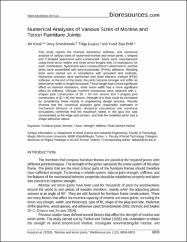Numerical Analyses of Various Sizes of Mortise and Tenon Furniture Joints
Abstract
This study reports the moment resistance, stiffness, and numerical analysis of various sizes of round-end mortise and tenon joints. L-shaped and T-shaped specimens were constructed. Joints were manufactured using three tenon widths and three tenon lengths with 10 replications for each combination. Specimens were constructed of Turkish beech, and the joints were assembled with polyvinylacetate (PVAc) adhesive. Bending tests were carried out in compliance with accepted test methods. Numerical analyses were performed with finite element method (FEM) software. At the end of the study, the joints became stronger and stiffer as either tenon width or length increased. Tenon length had a more significant effect on moment resistance, while tenon width had a more significant effect on stiffness. Ultimate moment resistances were obtained with Lshaped joint construction of 50 x 50 mm tenons and T-shaped joint construction of 40 x 50 mm tenons. Strength of a chair could be increased by considering these results in engineering design process. Results showed that the numerical analyses gave reasonable estimates of mechanical behavior of joints. Analytical calculations and numerical simulations confirmed that the maximum stress in the glue line was concentrated at the edge and corners, and that the modeled joints had a shape-adhesive nature.


















